Using rockwool to grow cannabis has become extremely popular, and for good reason, because it has many benefits.
A rockwool cube may be used for cannabis seed germination, but more commonly rockwool cubes and rockwool slabs are used for hydroponic growing.
Hydroponic growing systems involve the use of water as the main growth medium, along with some type of inert substrate such as coco coir or rockwool.
While many people may not be aware that hydroponic growing systems still require some kind of medium for the roots to hang onto, there are those that know all about rockwool, and after today, so will you.
Today, we want to take a closer look at using rockwool as a growing medium in hydroponic systems, as opposed to using potting soil, hence why this is known as a soilless media growth method.
Right now, we’re going to provide you with an in-depth guide on growing cannabis in rockwool, and yes, if taken care of properly, most plants will do just fine using this method!
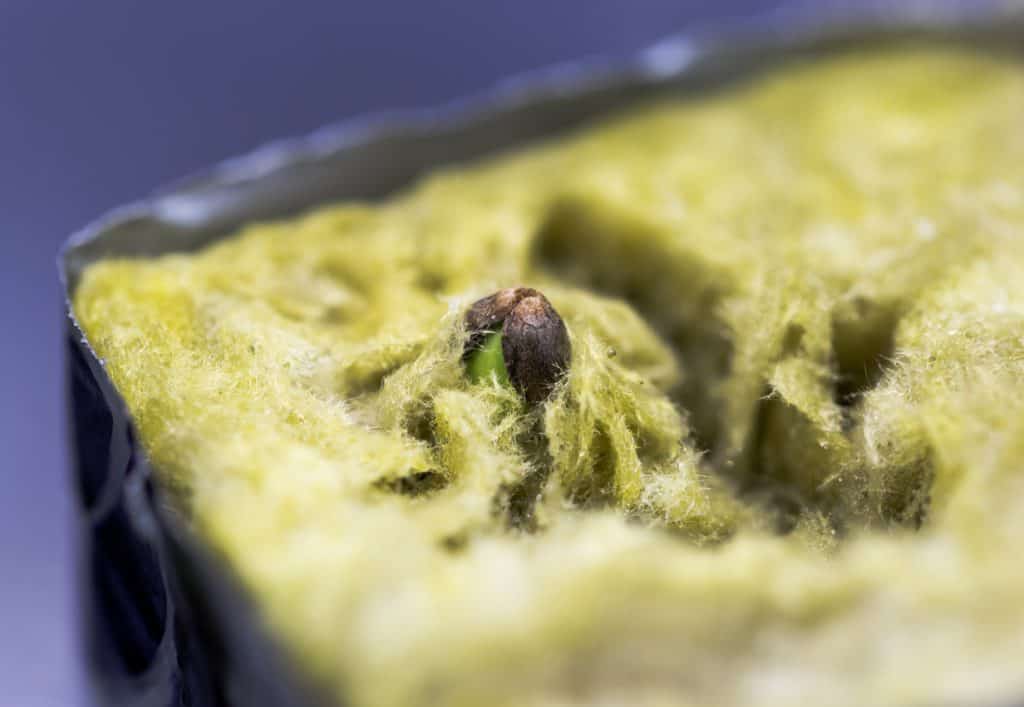
What is Rockwool AKA Rockwool Cubes?
Rockwool can come in many different forms, and they are all natural materials. You can use rockwool cubes or even get a whole rockwool slab too. This is a type of mineral wool, otherwise known as stone wool, made out of woven fibers
The manufacturing process of rockwool is quite simple. Rockwool starts with basalt rock and chalk, which are melted using very high temperatures. Basaltic rock has various properties that make it a leading choice for growing plants and ideal plant development.
This molten material is then spun into what we know as rockwool fibers, almost like making cotton candy. These Rockwell fibers are then compressed into cubes, blocks, or slabs, which are then used as growing mediums.
How is Rockwool Used in Cannabis Growing?
Rockwool used in cannabis growing in two main ways. First, it is often used for cannabis seed germination. Germinating weed seeds in rock wool is very easy.
Due to its composition, it provides cannabis seeds with an inert medium to start the germination process in, with one of the biggest benefits being that it has excellent water and air retention, not to mention that it is also pH neutral. If you want to germinate seeds, even if you are going to use soil afterwards, starting off with rockwool is always a good idea.
However, rockwool is most commonly used as growing media or a growing medium for hydroponic gardening. When engaging in hydroponic gardening, rock wool makes for a rather perfect growing media, as it has many benefits, particularly for the root zone of your cannabis plants.
Rockwool cubes provide your plants with the perfect base to root in, with hydroponic plants often developing high-quality root zones, both due to growing media such as rock wool and those high-quality hydroponic nutrient formulas that everyone uses.
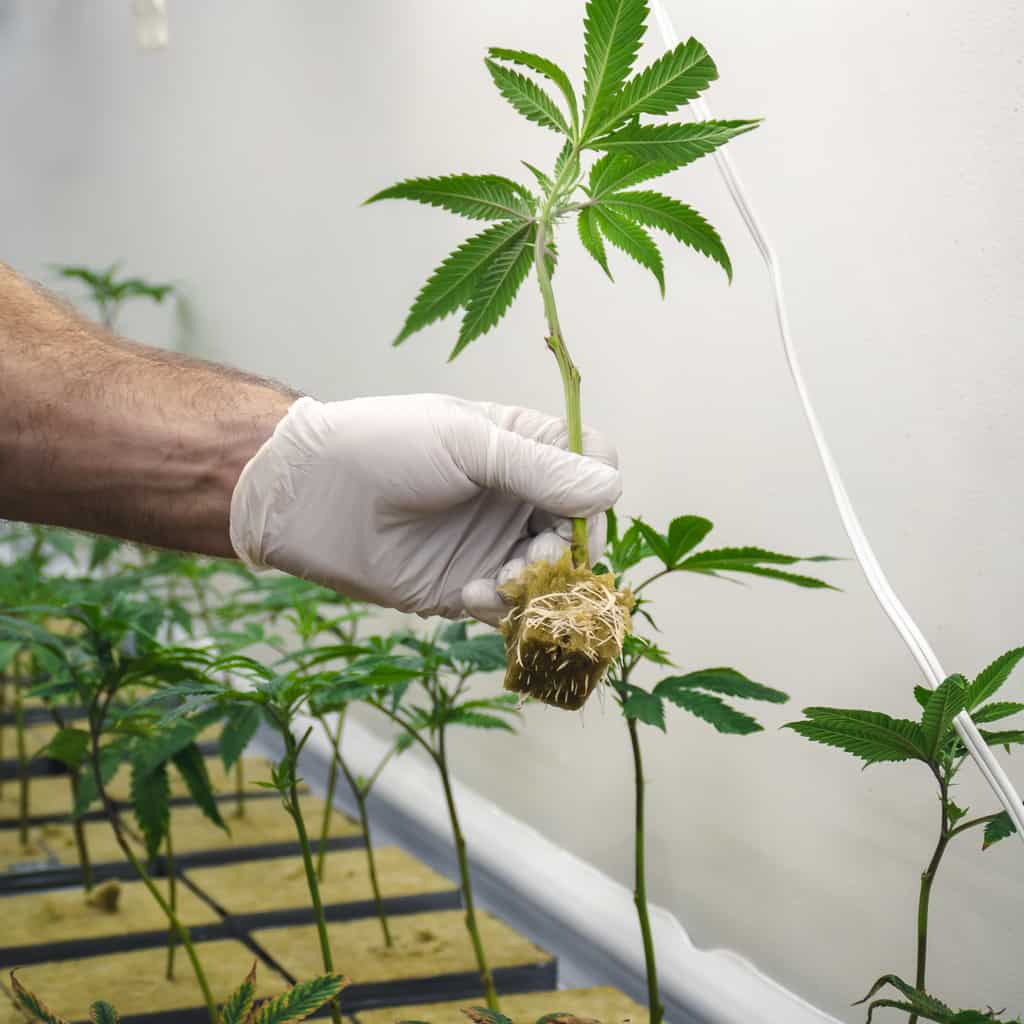
Benefits of Using Rockwool to Grow Cannabis
There is a reason why so many people use rockwool cubes as the main growing medium for cannabis, because it has great advantages for plants growing in hydroponic systems. Below we have listed some of the main advantages that plants growing in rock wool have.
· One of the biggest advantages that come with using rockwool for cannabis growth is that it can be reused. It is possible to reuse rockwool if you wash it properly and maintain it in between growth cycles.
· Rockwool is also totally inert and pH neutral. This means that it should not affect water chemistry or pH levels at all. This then allows you to more easily control the pH levels in the nutrient solution, which in turn can help lead to healthy root development.
· If we are talking about using rockwool to germinate seeds, a big benefit is that it has great water and air retention, therefore allowing for a steady supply of oxygen and water to the roots of the plant.
· Many people also really like using rockwool for a hydroponic system because it is very easy to handle, not to mention that it allows for great root growth, nutrient uptake, plant stability, and so much more.
· The fact that rock wool comes in rockwool cubes, rockwool slabs, and many other shapes and sizes, it means that it can be used for diverse hydroponic cannabis growth systems.
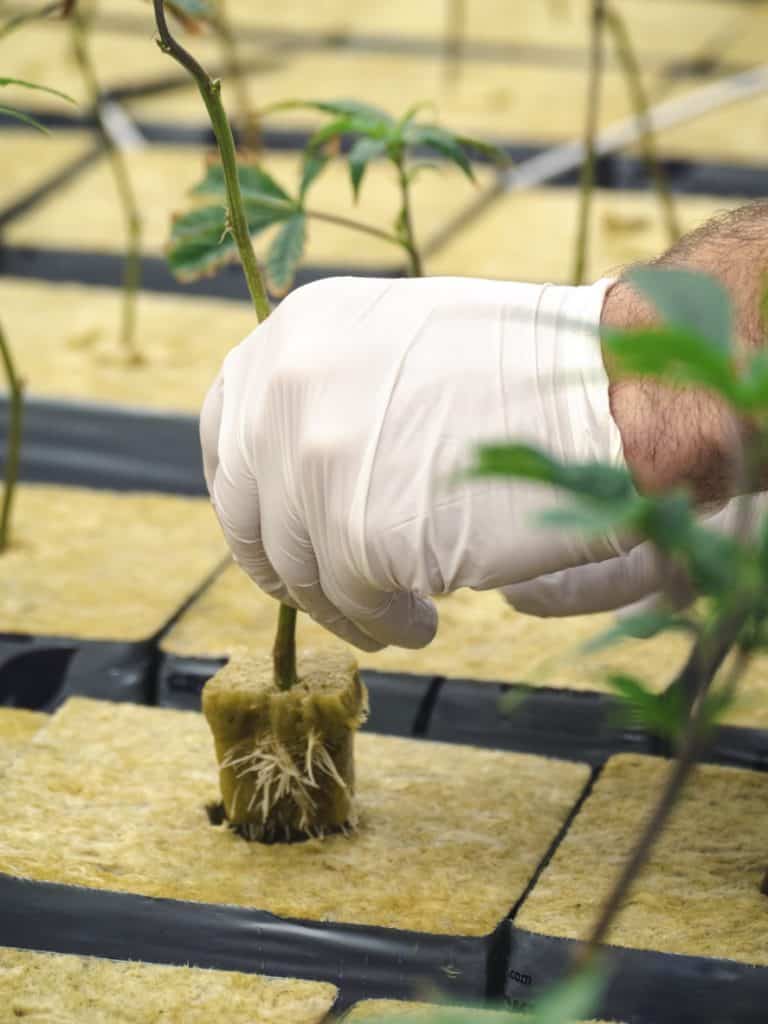
Growing Cannabis in Rockwool: A How-To Guide
Now that we know what the main benefits of growing cannabis in rockwool are, especially when it comes to hydroponic systems, let’s go through an in-depth step-by-step guide on how to grow cannabis in a rock wool in combination with a hydroponic setup.
1. Starting the Process
the first step here is to gather all of your equipment and necessary items required to grow your cannabis in rockwool hydroponically. First, you need to decide whether you will germinate weed seeds from start, if you will use weed clones from a mother plant, or if you will use stem cuttings.
You will also need to get yourself pH and EC meters, rockwool cubes or rockwool slabs, pH adjustment tools, grow lights, and a hydroponic system. We recommend using either a drip system or a flood and drain system, as these tend to be best for beginners.
You then need to prepare rockwool properly for use, as this will provide your weed plants with a sterile environment to grow in. In order to stabilize the pH level of the rockwool you must first soak it in pH adjusted water. You don’t want to squeeze out most of the water, to ensure that the cubes are moist, but not totally waterlogged.
2. Germinating Seeds and Planting
Germinating seeds is the first official step of this process, and you can use any method you see fit, whether a water glass, or paper towel, or even putting the weed seeds right in the cubes. That said, we recommend using the paper towel method, and then once the seeds have sprouted, transplanting them into the rock wool cubes that have been presoaked.
On the other hand, if you are using clones from a mother plant, prepare them appropriately, apply a routing solution for proper root growth, and then put them directly into the rockwool cubes that have been presoaked. It is a good idea to use a humidity dome or moisture dome here to ensure that root development happens quickly and properly.
3. Transplanting the Seeds
Before you transplant the cannabis seedlings into larger hydroponic containers or systems, you want the cannabis plants to develop very healthy root systems within the rockwool cubes or rockwool slabs.
You don’t want to plant the cannabis seedlings directly in larger hydroponic setups without first allowing that root system to develop.
This generally means allowing the root system to develop until you can visibly see the roots coming out of the rockwool cubes. At this point, you can transplant the cannabis seedlings into much larger hydroponics containers.
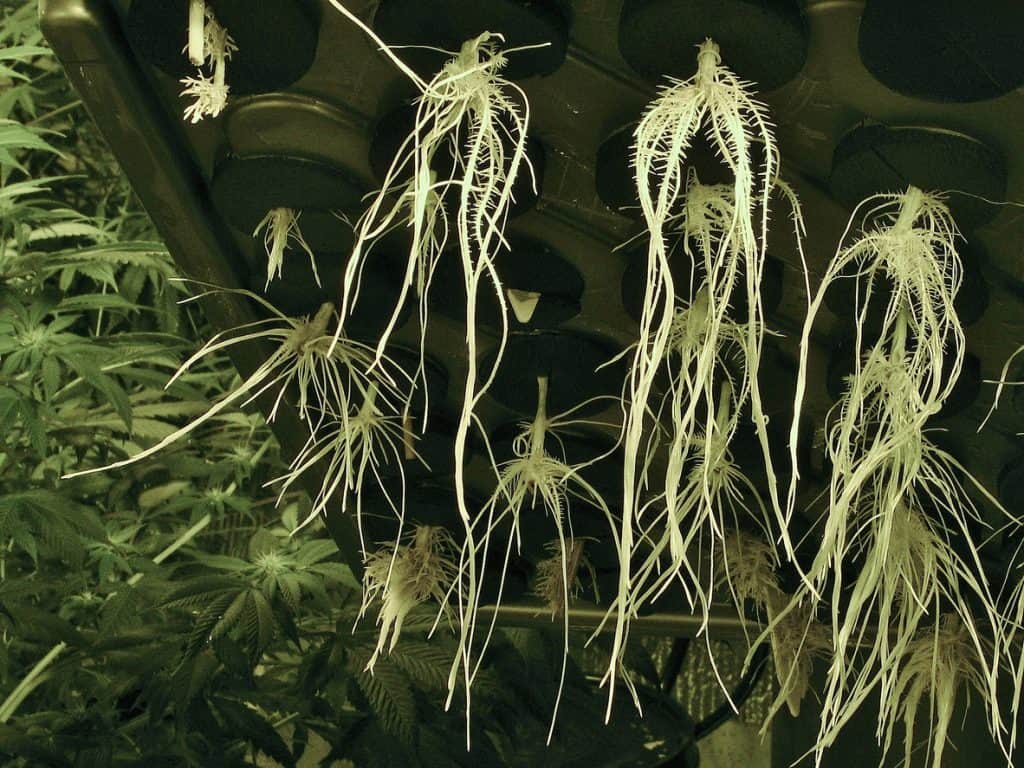
4. Nutrient Solutions
Of course, if you are growing hydroponically, this means that your cannabis plants will not get any nutrients from soil, plus rockwool itself also doesn’t contain any nutrients.
Therefore, you need to do a bit of research in terms of the proper nutrients and nutrient levels to use when growing cannabis hydroponically, specifically in relation to rockwool. You will of course need those three main nutrients, nitrogen, potassium, and phosphorus, otherwise known as the NPK nutrients.
You also need to use an EC meter to measure those nutrient concentrations, because weed being grown hydroponically is extremely susceptible to differing nutrient levels. You also need to manage pH levels within the nutrient solution and the hydroponic water itself.
Make sure that the water and nutrient solution features a pH level between 5.5 and 6.5. This will allow for great root system development and will allow the cannabis plants to uptake nutrients properly. Optimal nutrient uptake is very important here, because this is one of the biggest deciding factors in terms of how well those cannabis plants will grow.
5. Controlling Environmental Factors
Just like cannabis plants being grown in soil, both being grown hydroponically also require the proper amount and types of light. Therefore, provide your cannabis plants with the right amount and type of light for all growth stages, whether vegetative or seedling. If you are cultivating cannabis using raw coal, using either HID or LED lights is recommended. Make sure to not keep them too close to the plants however, or else the plants may burn.
Furthermore, you also want to maintain a relative humidity level of between 40% and 60%, as well as a temperature between 70 degrees and 80 degrees Fahrenheit. This means that you may need to use either heaters or air conditioners, as well as humidifiers or dehumidifiers, depending on the climate and environment that you live in.
6. Feeding
Keep in mind that rockwool is great at retaining moisture, so you usually won’t need to add too much water into the system very often. Just water the rockwool cubes very lightly when they feel a bit dry, but be sure not to overwater them.
Overwatering your cannabis plants can cause root rot and limit nutrient uptake. Exactly how often you will need to feed your cannabis plants will depend on the exact type of hydroponics nutrients that you are using.
On that note, using high quality nutrients designed specifically for growing cannabis hydroponically is required here. You cannot use the same type of nutrients that you would use to grow cannabis in soil.
7. Transition from Veg to Flowering
Once your cannabis plant has been indeed vegetative stage for roughly 12 weeks, give or take, depending on the exact strain you have, you then need to adjust the light cycle to induce cannabis flowering.
This means that you need to address the lighting schedule from 24 hours or 18 hours of light per day went down to 12 hours of light and 12 hours of darkness. This will encourage the cannabis plant to start flowering.
While the cannabis plant is flowering, need to maintain ideal pH levels, nutrient levels, temperature, humidity, and lighting. You also need to keep a close eye on things to catch nutrients deficiencies and pest issues as they occur.
8. Harvesting
when he burns up the cannabis plant are mature, which you can determine by examining both the pistils and the trichomes, then it is time to harvest your plants, which starts by cutting them down half the stem.
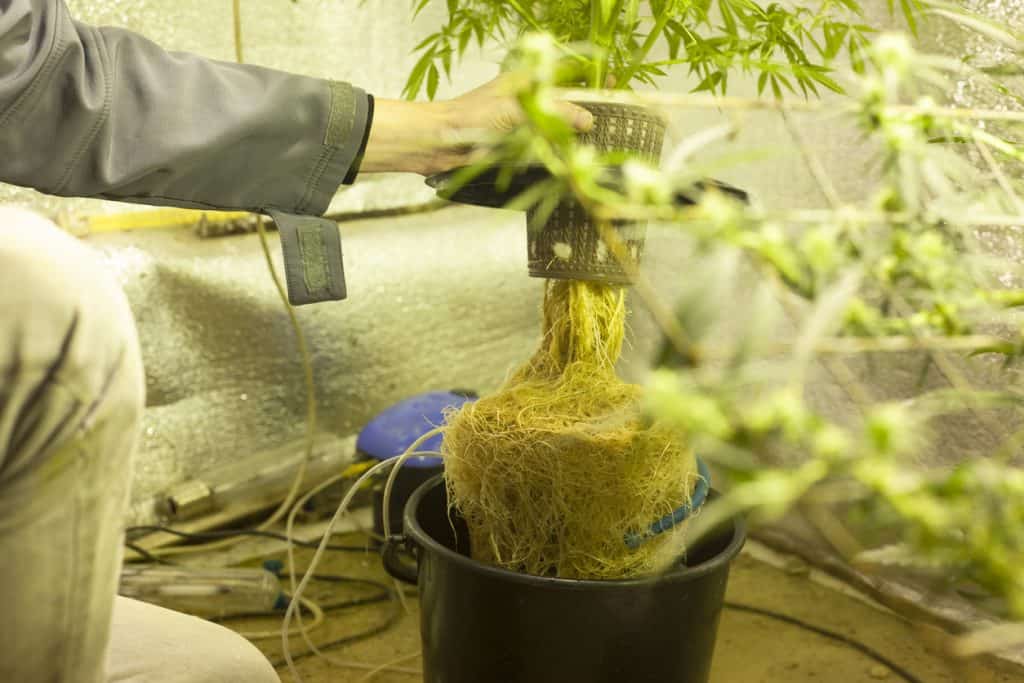
Tips to Maximize Plant Growth
Growing cannabis hydroponically can be a bit of a challenge, so we want to give you a few tips on how you can maximize plant growth and your overall plant yields.
· One of the best ways to increase cannabis growth rates and overall yields is by using training techniques. There are a variety of cannabis training techniques that can be used, with topping the cannabis plant being one of the most popular. You may also use the tie down method. You then also have the main line method at your disposal, which is like a combination of the above two.
· Providing your cannabis plants with the right amount of light is also essential. Make sure to provide your cannabis plants with up to 40 watts of light per square foot, and make sure that the lights are roughly 18 to 24 inches away from the plants.
· If you really want to give your cannabis plants a boost and a leg up over the competition, injecting some additional CO2 or carbon dioxide into the water is always a good idea. Plants always do exceptionally well when they receive additional carbon dioxide. Although it will cost you to add a CO2 setup into your hydroponics system, it is generally well worth the investment considering the much greater yields it tends to produce.
Conclusion
We hope that this in-depth guide on using rockwool for hydroponic cannabis growth has been helpful. Remember that this is by far one of the best growing medium that you can use in combination with a hydroponic setup, because it has many different beneficial features. If done properly, using rockwool in combination with a hydroponic system can result in some of the biggest yields and most potent buds around.
